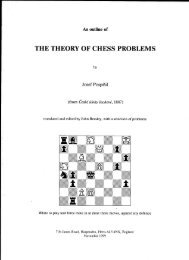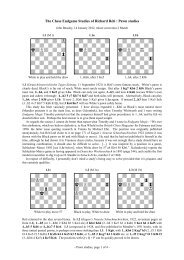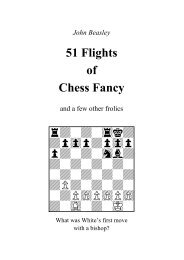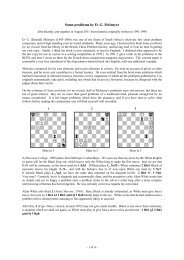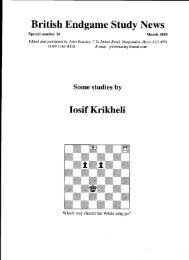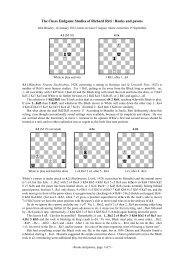A tribute to G. W. Chandler - John and Sue Beasley
A tribute to G. W. Chandler - John and Sue Beasley
A tribute to G. W. Chandler - John and Sue Beasley
You also want an ePaper? Increase the reach of your titles
YUMPU automatically turns print PDFs into web optimized ePapers that Google loves.
Two-movers 13<br />
7 (The Observer, 17 June 1945). Again there is no prominent Black move <strong>to</strong><br />
be met, but the White queen is currently restrained by the need <strong>to</strong> guard both e5<br />
<strong>and</strong> g5, <strong>and</strong> sooner or later we are bound <strong>to</strong> try 1 Kh6 which takes over the guard<br />
of g5 <strong>and</strong> threatens 2 Qc7. It exposes the king <strong>to</strong> check, 1...b5+, but this check<br />
obstructs the diagonal a6-f1 <strong>and</strong> allows mate by 2 Bb6, <strong>and</strong> two other thematic<br />
lines also exploit obstruction of this diagonal: 1...Nc4 2 Nd3 <strong>and</strong> 1...Nd3 2 Ne2.<br />
If 1...c4 then 2 Qxd5.<br />
8 (The Observer, 1 February 1948). This time, it will be the White queen’s<br />
turn <strong>to</strong> do the hard work. Moves such as 1...Nxa4 create a flight square on e4, so it<br />
is natural <strong>to</strong> withdraw the White bishop so as <strong>to</strong> guard this square, <strong>and</strong> 1 Bf3 turns<br />
out <strong>to</strong> be the correct move. It threatens 2 Re4, <strong>and</strong> we have 1...Nxa4 2 Qb8,<br />
1...Nc4 2 Qb5, 1...Qb1 2 Qxc3, 1...Nd3 (2 Re4? Kd5) 2 Qxe2, <strong>and</strong> 1...B-- 2 Qh2.<br />
The reason that the key bishop has <strong>to</strong> move <strong>to</strong> f3 is <strong>to</strong> shut off the Black rook in<br />
lines such as 1...Bxd1 2 Qh2.<br />
9 (Stratford Express, 25 August 1950). The flight-creating moves 1...Rxf3<br />
<strong>and</strong> 1...Bxf3 can be met (1...Rxf3 2 Rxe2, 1...Bxf3 2 R5d3), but 1...Bd4 needs<br />
attention. The key 1 Ra2 takes over the guard of d2 <strong>and</strong> so provides for it (1...Bd4<br />
2 Bxd4), <strong>and</strong> it also prevents 1...Qxa1 <strong>and</strong> threatens 2 Re5. There are several<br />
defences <strong>to</strong> this, leading <strong>to</strong> varied play, but the star lines are the long-distance<br />
mates 1...Bb6 2 Qh6 <strong>and</strong> 1...d6 2 Qe8 exploiting the obstruction of the sixth rank.<br />
10 (The Observer, 1 Oc<strong>to</strong>ber 1950). The flight-creating move 1...f2 needs<br />
attention, <strong>and</strong> the key is 1 Ra5, ab<strong>and</strong>oning the battery in order <strong>to</strong> threaten<br />
2 Bxd5. Any move of the knight on d5 will defeat this threat, but a nondescript<br />
move such as 1...Nxc3 allows the discovery mate 2 g5 (the rook on a5 now<br />
guarding f5) <strong>and</strong> four attempted corrections also fail: 1...Ne3 2 Nf2, 1...Nf4<br />
2 Re5, 1...Nf6 2 Ng5, <strong>and</strong> 1...Ne7 (unpinning the knight on e6) 2 Nf6. Two lines<br />
exploit self-blocks, the other two the obstruction of the diagonal from d8.<br />
11 (2nd Prize, The Problemist, March 1952). Again the battery is a spoof,<br />
<strong>and</strong> the key is 1 Qd8, ready <strong>to</strong> takeover the guard of g5 in the threatened mate<br />
2 Be5. Any move of the knight on d4 will defeat this by letting the bishop through<br />
from a1, but a nondescript move such as 1...Nb5 allows 2 Qd2, the pawn on e4<br />
now being pinned, <strong>and</strong> again there are four attempted corrections which fail:<br />
1...Nf5 2 Rg4, 1...Nf3 2 Ne2, 1...Nc2 2 Nd3, <strong>and</strong> 1...Nb3 2 Ne6. An amusing<br />
subsidiary line is 1...Ne7 2 Qxc7.<br />
12 (The Glasgow Herald, 29 August 1952). Another composition on the<br />
same theme. The key 1 Nf6 threatens 2 Rxe4, which any move of the knight on<br />
d3 will defeat, but a nondescript move such as 1...Nc1 allows 2 Qxb5 <strong>and</strong> once<br />
more there are four attempted corrections which fail: 1...Nb2 (unpinning the rook<br />
on c3 but obstructing the second rank) 2 Qh2, 1...Nb4 2 Bxc3, 1...Nc5 2 Rd5, <strong>and</strong><br />
1...Nf4 2 Ng4. This was a version (<strong>and</strong> in my view an improvement) of a problem<br />
which was awarded 6th honourable mention in the Olympic Tourney of 1948.<br />
Particularly neat is the line 1...Nf4 2 Ng4, when the key knight, whose role<br />
appears merely <strong>to</strong> have been <strong>to</strong> guard e4 <strong>and</strong> set the mechanism in motion,<br />
suddenly finds itself giving a mate.



